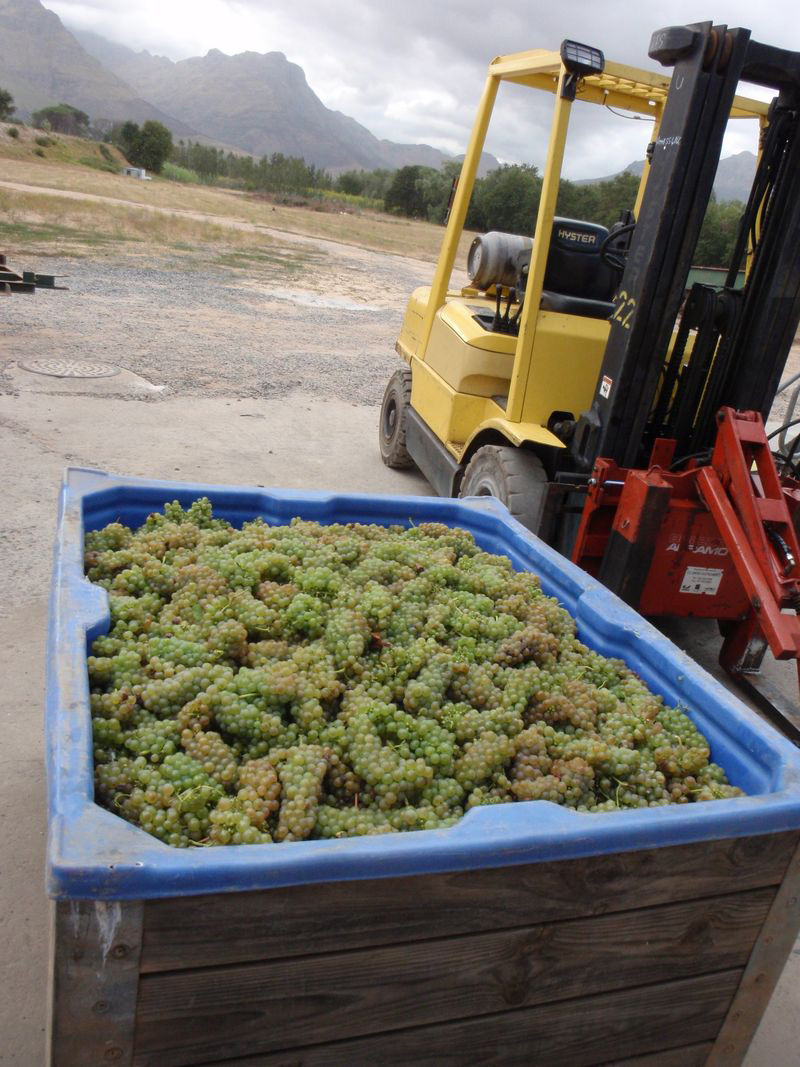In South African Wine on 12 Feb 2010
Blaauwklippen’s 2010 harvest kicked off at 7 this morning with viognier picked from our lovely but unromantically-named Tekno Park vineyard across the street next to the Kleine Zalze winery. The first bins of grapes arrived at about 9, so we had some time to go over equipment use and logistics with our winemaker Rolf. My job for the day was running the crusher, which collects the grapes as we dump them from the bins and knocks them loose of their stems. They’re then pumped into the press, where they’re squeezed and pumped into a tank for fermentation. Here at Blaauwklippen we only use the yeast that is found naturally on the skins of grapes, so at that point the fermentation has begun.

These grapes were picked at about 21.5 degrees Balling/Brix and at a pH of 3.2, which means they could’ve stayed on the vine a bit longer. Rolf wanted a nice acidity and low alcohol level for this viognier, which he plans to blend with purchased Sauvignon Blanc to make our White Landau blend.
He showed me how to analyze a grape by look and taste: is the pulp juicy or more textured? Are the seeds brown or still a bit green, and do they crumble easily when you bite them? Is the skin grainy and tannic? What are the flavors? How sweet is the grape?
All these tests need to be done on grapes taken from both sides of a cluster, since one side will have more sun exposure. I eat stuff like this up (no pun intended)––after weeks in the lab taking numerical readings of sample juice, sensory grape analysis is just plain fun.
Once we got things going I couldn’t believe how quickly the day went by. By 5:00 we were finished crushing, having juice-ified 15 tons of grapes. I know it’s only the first day but I have to say harvest feels more like a party than hard work at Blaauwklippen: there was pan-fried calamari for lunch and two “tea time” breaks, a “Play That Funky Music White Boy” dance-off, lots of snacking on grapes, and endless wisecracks at the expense of anyone who remained grumpy.
After cleaning up (it occurred to me today while hosing down equipment that “cleaning up” is often the part of the job that makes you dirtiest) we took Albert and his wife Esme to dinner to thank them for the wonderful weekend in Langebaan. They suggested Wijnhuis (Wine House), a beautiful, romantic spot in the heart of Stellenbosch. It’s the kind of place where I’d hang out every night if I could afford it. The menu is an extensive and creative mixture of classic Italian and traditional South African with a locally focused wine list to match. I was in heaven. We started with Tokara’s 2007 white blend, 85% sauvignon blanc and 15% semillon, which was oaky, figgy and great with my pan-fried calamari appetizer. Albert brought Glenelly’s entry-level Zebra red Cape blend for dinner. It had a classy, rather French lead/pepper nose for a blend that describes itself as “fun-loving” and a very smooth finish, a great compliment to my entrée: gemsbock filet.
Apparently a gemsbock is one of the most elegant of the gazelle family; Esme encouraged me to look for one at one of the Western Cape’s game preserves so I could experience its beauty. At least I experienced its deliciousness! It was even more tender and flavorful than good venison, a nice match for a pinotage-heavy Cape blend.
At dessert time I had to try a local port. I opted for Morgenhof LBV and discovered a port that drank like an aged Spanish blend: dusty, a haunting mix of spices, not too sweet and perfect with my malva pudding (a South African bread pudding made with marula cream liqueur). It was the perfect meal to kick off the harvest––and since I have the weekend off from pumpovers, I’ll be able to sleep it off in style!